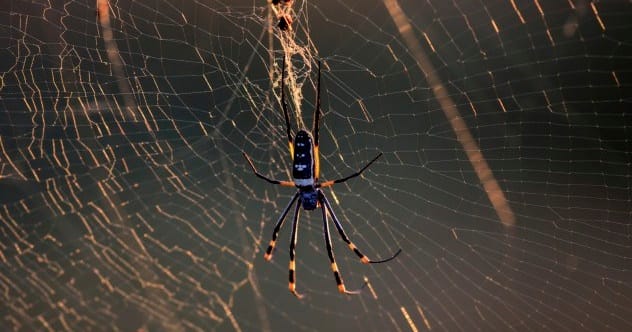They’re creepy, crawly, and often the stars of our nightmares. But what if we told you these eight-legged creatures are also unsung heroes of innovation? It’s true! Spiders, often shooed away or met with a shriek, have secretly been spinning threads of inspiration for scientists and engineers. Forget the fear for a moment; these arachnids are behind some truly mind-blowing advancements. Let’s explore 10 incredible (plus a bonus!) ways spiders are helping us weave a brighter future. Prepare to be amazed by what these “horrors” have helped us dream up!
10 Better Than Band-Aids: Surgical Tape That Adheres to Wet Surfaces
We’ve all fumbled with bandages that slip off the moment they get wet. It’s frustrating, right? But spiders, with their super-sticky webs that cling even in damp conditions, have shown us a better way. Scientists at MIT took a cue from these arachnid architects to develop a groundbreaking surgical tape.
This isn’t your average medical tape. It’s a double-sided adhesive designed to stick to wet surfaces, like internal organs during surgery, and seal wounds in seconds! Imagine a tape that uses water to become stickier, just like a spider web traps dew-kissed insects. It’s made with polyacrylic acid to absorb water and create a strong bond, reinforced with gelatin that safely dissolves in the body as you heal. Say goodbye to annoying tape changes and second trips for stitch removal!
9 Step Back, Kevlar: Spider Silk Body Armor
You’ve probably heard of Kevlar, the tough material used in body armor. But did you know it was also inspired by spider silk? Well, move over Kevlar, because spider silk itself is leading to even stronger protective gear! Imagine armor that’s lighter yet significantly more effective.
It takes a whopping 33 layers of Kevlar to stop a .22 caliber bullet. But a new material called “Dragon Silk,” made from the silk of Golden Orb Weaver spiders, can do the same job with just four layers! This incredible strength has caught the attention of the U.S. Army, which is investing in its production. Researchers are also creating artificial spider silk, like the “polymeric amyloid” fiber, hoping to make materials even stronger than the real thing. It’s clear that spiders, bacteria, and brilliant human minds make a powerful team!
8 Webs Used for Micro-Imaging: Tiny Dome Lenses
The medical field is really embracing the amazing abilities of spiders. Researchers in Taiwan are crafting incredibly tiny lenses, inspired by spider webs, that can be used for imaging inside the human body. How tiny? These lenses are almost as small as a red blood cell! This means they could travel nearly anywhere blood flows, offering revolutionary possibilities for medical diagnosis.
To create them, scientists use the “dragline silk” from Daddy Long Legs spiders – the very silk they use to frame their webs. Resin is dripped over this silk scaffold and then baked. The result is a bio-friendly lens, safe for use within the body, capable of nanoscale imaging. This could make medical investigations far less invasive than current methods. Who knows, maybe we’ll even develop Spidey-senses as a cool side effect!
7 Cheeky Devils!: Spider Venom May Be Better Than Viagra
Here’s a surprising one! Men bitten by the Brazilian Wandering Spider, one of the world’s most venomous, have reported an unusual side effect beyond intense pain: very persistent erections. Now, we’re definitely not suggesting you go looking for this eight-legged nightmare! However, scientists have taken note and are using toxins from its venom to create a gel that produces similar results.
The BZ371 gel might need a catchier name, but it reportedly works wonders within 20-30 minutes of application, without needing prior stimulation, and has no reported side effects. The effects are said to last for about an hour. It’s another instance where something fearsome from nature offers an unexpected solution.
6 Eight Spindly Limbs: Inspiration for More Efficient Robots
Even if the sight of a spider scurrying makes your skin crawl, you have to admit their movement is unique and allows them to do some pretty amazing things. If humans could move like spiders, we’d be practically unstoppable! While we can’t replicate their eight-legged agility, the world of robotics is certainly taking notes.
Researchers have designed robotic limbs and joints that mimic spider legs. This allows for robots with greater functionality using fewer components. The outcome is lighter, smaller parts with superior mobility, which can be used in all sorts of robots. This innovation has been praised as a significant leap forward in robotics. High-eight, spiders! (From a safe distance, of course).
5 We Can All Potentially Be Spider-Man!: Real Web Shooters
Admit it, who hasn’t dreamed of shooting webs like Spider-Man? It’s a fantasy many of us have entertained, even as adults. Well, someone is working hard to bring this comic book dream to life! These real-life web shooters might one day even allow us to swing between buildings—though you’d probably need some serious gymnastic skills for that.
A mechanical engineer and YouTuber from South Africa, JT, has created impressive web-shooters as part of a thesis project, showcased on his channel, Built IRL. He uses metal cylinders containing a long cable with metal hooks, powered by compressed propane and a custom igniter. It’s amazing to see life imitate art, especially when that art was inspired by creatures that give many of us the shivers! Go, Spidey-JT!
4 Trendy, Functional Spider-Wear: Sustainable Web-Inspired Fashion
The fashion world is known for pushing boundaries, sometimes into the realm of the impractical. However, it’s also an industry ripe for sustainable change, especially given concerns about fast fashion, synthetic fibers, and toxic production processes. And guess who’s spinning a solution? Spiders, of course!
A company called Bolt Threads has bioengineered yeast with a spider silk protein gene. As this yeast ferments, it produces silk protein that is then purified and spun into a textile called MicroSilk. Adidas has already used a hybrid of this material for a lightweight tennis dress. Another company, AMSilk, has created a similar material, BioSteel, which Adidas used in a sneaker. Even the airline industry is showing interest in these synthetic silks due to their potential for weight reduction. It’s innovation mimicking nature to help save nature – truly glorious!
3 Poison Can Kill Pain: Tarantula Venom Could Replace Opioids
The dangers of synthetic opioids are well-known, with side effects ranging from rashes and nausea to addiction and respiratory distress. There’s a desperate need for safer alternative pain treatments for those suffering from chronic and neuropathic pain. Science, with a little help from tarantulas, is on the case.
Researchers at the University of Queensland have discovered molecules in tarantula venom from the Chinese Bird Spider. These can be developed into mini-proteins that target pain receptor cells. When administered correctly, these proteins can surround the cell membrane around pain receptors, effectively blocking pain signals. So far, studies on mice show promising results for future pain reduction with no recorded side effects. It’s incredible to think that something delivering intense pain could also be used to combat it!
2 Spider Silk Milk: Goat Genes Manipulated to Produce Spider Silk
Move over, Dr. Frankenstein; biomimicry science is taking huge leaps! We’re increasingly learning from nature instead of trying to control it. A company named Nexia has genetically engineered goat eggs by incorporating silk genes from Golden Orb Weaver spiders. The result? Goats that produce spider silk proteins along with their milk!
Why do this? Spider silk is famously as strong as, or even stronger than, steel, yet incredibly flexible and durable. These properties could revolutionize everything from constructing earthquake-resistant buildings to creating materials for surgical grafting. Mass-producing this wonder material is an attractive goal. While the ‘goat silk’ isn’t quite up to par with what spiders naturally produce… yet, scientists are continuing to weave their magic until it is.
1 Reflective Webs Can Save Birds: UV-Reflective Glass
Ever heard that startling thud of a bird colliding with a window? It’s a common and sad occurrence. But did you know that spiders inadvertently offer a solution? Birds can see ultraviolet (UV) light, a spectrum invisible to us. Spider webs naturally reflect UV light, making them visible to birds, who can then avoid flying into them. This saves the spider a lot of rebuilding effort and protects our feathered friends.
This neat trick of nature inspired a German glass company, Glaswerke Arnold, to develop Ornilux Bird Protection Glass. This glass is embedded with UV-reflective strands. To us, it looks like a normal pane of glass, but to birds, the chaotic UV patterns signal an obstacle. Buildings using this glass have seen a 75-90 percent reduction in bird strikes! Developed in 2006, this bird-saving technology is now becoming widely adopted. Hooray for bird safety and spider smarts!
+ Spider Music!
And for a truly unique innovation: people have now used the structure of spider webs to create music! Yes, you read that right. By translating the 3D architecture of a web into musical notes and pairing it with visuals, scientists and artists have created an eerie and beautiful auditory experience. The project, Spider’s Canvas, was a collaboration at MIT involving engineering and music departments.
This hauntingly beautiful work truly blurs the lines between art and science. Halloween might just have a new official theme song, courtesy of our arachnid composers!
It’s clear that spiders are much more than just creepy crawlies. These remarkable creatures have spun a web of inspiration, leading to breakthroughs that touch almost every aspect of our lives – from life-saving medical treatments to stronger materials and even eco-friendly fashion. The next time you see a spider, perhaps you’ll pause and appreciate the tiny engineer whose natural brilliance is helping humanity solve complex problems. Our nightmares about them are slowly transforming into dreams of a more innovative future, all thanks to these eight-legged wonders.
Which of these spider-inspired innovations amazed you the most? Do you know of any others? Share your thoughts in the comments below!










